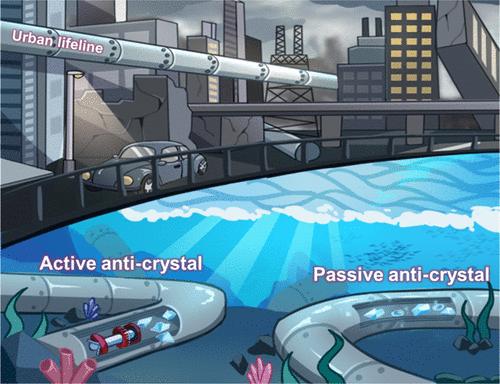Spontaneous Lifting and Self-Cleaning of Gas Hydrate Crystals
IF 15.8
1区 材料科学
Q1 CHEMISTRY, MULTIDISCIPLINARY
引用次数: 0
Abstract
Crystal fouling, which refers to the accumulation of precipitates on surfaces and the associated damage, is a common problem in many industrial processes. In deepwater oil and gas transportation, hydrate blockage poses as a considerable barrier. Consequently, modifying hydrophobicity of surfaces has become an increasingly focused strategy to mitigate hydrate. However, the design of surfaces that effectively control the hydrate remains challenging. Herein, we report a superior smooth anti-hydrate material based on silanized modification. The low-adhesion silanized silicon wafer (SSW) realizes a win–win strategy of hard formation and easy removal. Through a comprehensive study combining experimental validation with theoretical analysis, the unique characteristics of SSW in the field of anti-hydrate surfaces were deeply discussed. Various hydrate crystals exhibited a completely different hydrate growth mode at the SSW surface, in which hydrate crystals spontaneously elevated and lifted themselves off from the surface. The presence of the fluorine element on the SSW surface allowed self-lifting growth of hydrate crystals after they covered the water droplet. And the loose and porous crystal structure in this self-lifting growth could reduce the contact area between the hydrate crystals and the substrate, allowing the crystals with minimal adhesion force and removal disturbance. Furthermore, the gas enrichment on the SSW surface also reduced the contact with the substrate, thereby decreasing the adhesion and allowing self-cleaning behavior. These results indicate that the silanized surface is a promising candidate for developing anti-hydrate materials for hydrocarbon production and transportation industry.

气体水合物晶体的自发提升和自我清洁
结晶堵塞是指沉淀物在表面上的积累和相关损害,是许多工业流程中的常见问题。在深水油气运输中,水合物堵塞是一个相当大的障碍。因此,改变表面的疏水性已成为一种日益受到重视的缓解水合物的策略。然而,设计能有效控制水合物的表面仍具有挑战性。在此,我们报告了一种基于硅烷化改性的优质光滑抗水合物材料。低粘附性硅烷化硅晶片(SSW)实现了不易形成和易于去除的双赢策略。通过实验验证与理论分析相结合的综合研究,深入探讨了 SSW 在抗水合物表面领域的独特特性。各种水合物晶体在 SSW 表面表现出完全不同的水合物生长模式,即水合物晶体自发升高并脱离表面。SSW 表面氟元素的存在使得水合物晶体在覆盖水滴后能够自升生长。而这种自升式生长中疏松多孔的晶体结构可以减少水合物晶体与基底的接触面积,使晶体的附着力和移除干扰最小。此外,SSW 表面的气体富集也减少了与基底的接触,从而降低了粘附力,实现了自清洁行为。这些结果表明,硅烷化表面是为碳氢化合物生产和运输业开发抗水合物材料的理想候选材料。
本文章由计算机程序翻译,如有差异,请以英文原文为准。
求助全文
约1分钟内获得全文
求助全文
来源期刊

ACS Nano
工程技术-材料科学:综合
CiteScore
26.00
自引率
4.10%
发文量
1627
审稿时长
1.7 months
期刊介绍:
ACS Nano, published monthly, serves as an international forum for comprehensive articles on nanoscience and nanotechnology research at the intersections of chemistry, biology, materials science, physics, and engineering. The journal fosters communication among scientists in these communities, facilitating collaboration, new research opportunities, and advancements through discoveries. ACS Nano covers synthesis, assembly, characterization, theory, and simulation of nanostructures, nanobiotechnology, nanofabrication, methods and tools for nanoscience and nanotechnology, and self- and directed-assembly. Alongside original research articles, it offers thorough reviews, perspectives on cutting-edge research, and discussions envisioning the future of nanoscience and nanotechnology.
 求助内容:
求助内容: 应助结果提醒方式:
应助结果提醒方式:


